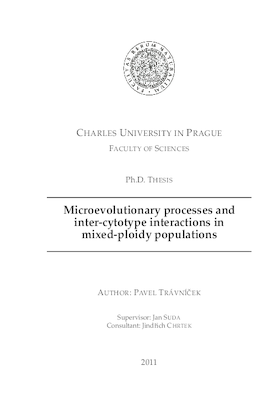Microevolutionary processes and inter-cytotype interactions in mixed-ploidy populations
Mikroevoluční procesy a meziploidní interakce v sympatrických populacích více cytotypů
dizertační práce (OBHÁJENO)

Zobrazit/
Trvalý odkaz
http://hdl.handle.net/20.500.11956/47877Identifikátory
SIS: 32877
Katalog UK: 990014440440106986
Kolekce
- Kvalifikační práce [21484]
Autor
Vedoucí práce
Oponent práce
Frajman, Božo
Zozomová, Judita
Fakulta / součást
Přírodovědecká fakulta
Obor
-
Katedra / ústav / klinika
Katedra botaniky
Datum obhajoby
2. 3. 2012
Nakladatel
Univerzita Karlova, Přírodovědecká fakultaJazyk
Angličtina
Známka
Prospěl/a
Klíčová slova (česky)
ploidní interakce, smíšené populace, polyploidie, průtoková cytometrieKlíčová slova (anglicky)
cytotype interactions, mixed-ploidy populations, polyploidy, flow cytometrySouhrn [Abstrakt] Cílem této dizertační práce je lepší porozumění schopnosti různých ploid- ních úrovní koexistovat ve smíšených populacích a zvláštní důraz je kladen na mikroevoluční procesy, které toto soužití umožňují. Naše dosavadní znalosti v tomto směru se opírají pouze o několik podrobně zkoumaných modelových dru- hů, jako je vrbovka úzkolistá, Epilobium (Chamerion) angustifolium či Heuchera gros- sulariifolia, nicméně některá odvozená zobecnění se zdají být ve světle nových poznatků jako minimálně předčasná. Detailní výzkum dalších cytotypově vari- abilních druhů zahrnutých v této práci jednoznačně ukazuje, že polyploidní kom- plexy se mohou velmi dramaticky lišit ve schopnosti jak se vypořádat s koexistencí cytotypů ve smíšených populacích. Zatímco některé druhy víceméně postrádají smíšené populace (takovým příkladem může být vikev ptačí, Vicia cracca; Článek III.), naproti tomu jiné druhy velmi často tvoří ploidně heterogenní populace, které jsou udržovány volným párováním všech cytotypů a absencí jakýchkoliv repro- dukčně izolačních bariér mezi nimi (příklad jestřábníku hadincovitého, Pilosella echioides; Článek II.). Síla a souhrnný efekt rozličných reprodukčních bariér (pre- i post-zygotických) určuje pozici konkrétního multiploidního komplexu mezi...
[Abstract] This thesis is aimed at better understanding of cytotype co-existence in mixed- ploidy populations with an emphasis on a microevolutionary processes behind it. Our past knowledge was based on a few thoroughly investigated model taxa like Chamerion angustifolium and Heuchera grossulariifolia, but some generalizations seem to be premature in the light of new findings. A detailed research of other taxa included in the thesis showed that polyploid complexes can vary dramatically in their ability to cope with the co-existence of cytotypes in mixed-ploidy popu- lations. Whereas mixed-ploidy populations are virtually lacking in some species (an example being Vicia cracca, Paper III.), ploidy-heterogeneous populations are very common in others, maintained by free mating interactions and the absence of reproductive isolation among cytotypes (e.g. Pilosella echioides, Paper II.). The strenght and cumulative effect of various breeding barriers (both pre- or post- zygotic) govern the position of a particular multi-ploidy complex between these two extremes and co-determine the type of cytotype co-existence in its mixed- ploidy populations. Despite the fact that the number of studies revealing cytotype co-existence has been increasing rapidly, evolutionary background and consequences of such co-...
